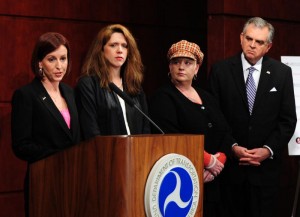
A year ago, the Department of Transportation helped launch FocusDriven, an advocacy group for victims of motor vehicle crashes involving drivers using cell phones.
“In one year, we’ve made progress – but at least 5,500 people still die every year in crashes,” said FocusDriven president Jennifer Smith, who lost her mother in a collision involving a distracted driver. Vulnerable road users like pedestrians and cyclists are especially at risk when drivers aren’t paying attention.
“I am noticing a lot of pedestrians and cyclists getting killed,” Smith said. “They’re at most danger. They don’t have the car to protect them. And these people are hitting them and not even realizing that they hit someone. That’s how engrossed in the conversation or the text message they are.”
At a press conference at the DOT headquarters in Washington, Secretary Ray LaHood listed the accomplishments of the relatively young campaign against distracted driving.
“In 2010, legislators in 43 states considered more than 270 distracted driving-related bills,” LaHood said. “Because of our collective efforts, 30 states have outlawed texting behind the wheel, and eight states have banned handheld cell phone use for all drivers.”
The Obama administration has also banned federal employees, commercial truckers and bus drivers from texting while driving.
Now he’s taking his message to the automakers. He’s already had talks with top officials at GM, Toyota, Nissan, Honda, and BMW. Tuesday, he’ll be in Detroit to talk to the chairmen of Ford and Chrysler. He applauds Subaru’s recent commercial featuring a father admonishing his daughter not to use her cell phone while driving.
And that’s the message he’s taking to the automakers: “devote some of your money that you’re devoting to advertising for your products to the idea that distracted driving is very dangerous.”
Automakers have made their attempt: GM and Saab vehicles now feature Onstar systems that allow drivers to answer the phone on their dashboard and talk without a handheld device. But Jennifer Smith says that’s not enough. “There are more than 25 credible research papers that show no safety improvement while using a hands-free device, yet we are continuing to be told that hands-free technologies are a safe alternative,” she said. “If our brains cannot process what our eyes are seeing, then we are at risk.”
Will LaHood settle for automaker efforts that include “safety” technologies that don’t keep us safe? He declined to comment on whether these technologies are the answer.
Meanwhile, he wants to see a federal bill like ones that were introduced, but not passed, in the last Congress. “I think a national law is a good idea,” he said. However, with 30 states already banned some cell use while driving, the states appear to be well ahead of the feds on this one.
Still, the secretary rests most of the responsibility with the driver who either decides to leave the phone in the glove box or doesn’t. Much of the language of the campaign against distracted driving is about choice. “Each day I get another reminder that someone made a choice that a phone call or a text message was more important than someone’s safety,” says Smith. “It was more important than someone’s life.”





